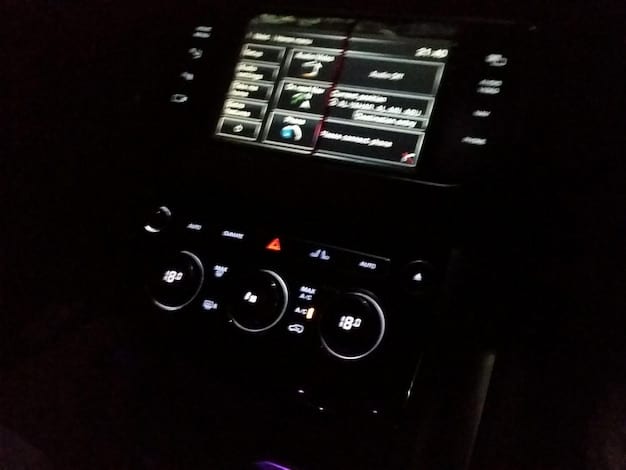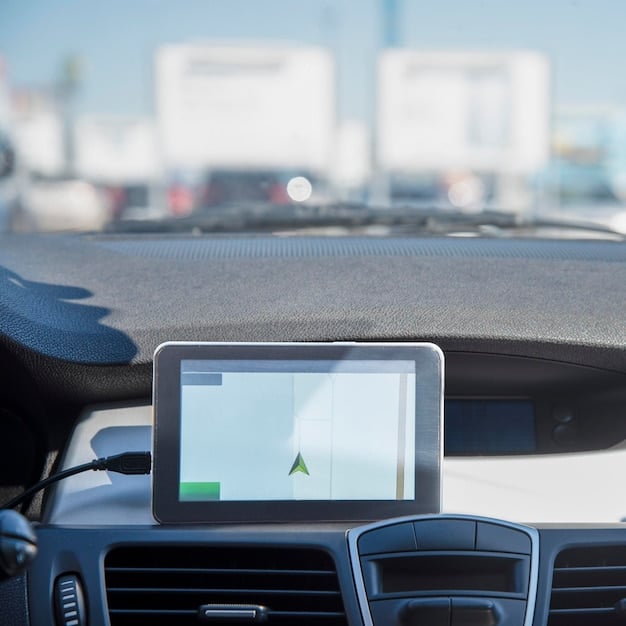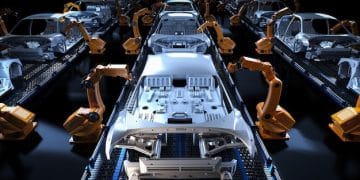The Rise of Software-Defined Vehicles: A 5-Year Outlook

Software-defined vehicles (SDVs) are revolutionizing the automotive industry, shifting from hardware-centric designs to software-driven platforms, promising enhanced connectivity, personalized experiences, and new ownership models within the next five years.
The automotive landscape is undergoing a fundamental transformation, driven by the advent of software-defined vehicles (SDVs). This shift promises to redefine not just how cars are built, but also how we own and interact with them in the coming years.
Understanding Software-Defined Vehicles
Software-defined vehicles represent a paradigm shift in automotive engineering. Unlike traditional vehicles where hardware dictates functionality, SDVs prioritize software, allowing for greater flexibility, customization, and continuous improvement.
The Core of SDVs: Software-Centric Architecture
At the heart of an SDV is a powerful computing platform that controls nearly all aspects of the vehicle, from engine management to infotainment. This architecture enables over-the-air (OTA) updates, feature enhancements, and personalized experiences.
Key Components of SDV Technology
Several core technologies underpin the software-defined vehicle revolution. These include advanced operating systems, middleware, cloud connectivity, and robust cybersecurity measures.
- Advanced Operating Systems: Provide the foundation for running complex software applications within the vehicle.
- Middleware: Facilitates communication and data exchange between different software components.
- Cloud Connectivity: Enables OTA updates, remote diagnostics, and access to cloud-based services.
- Cybersecurity Measures: Protect the vehicle’s systems from unauthorized access and cyber threats.
The transition to software-defined architectures enables auto manufacturers to create vehicles that adapt to changing consumer needs and technological advancements. This move will pave the way for innovative features and services previously unattainable in hardware-centric vehicles.

The Evolution of Car Ownership Models
The rise of SDVs is poised to disrupt traditional car ownership models, ushering in an era of greater flexibility, personalization, and access. New models are emerging that cater to diverse consumer needs and preferences.
Subscription Services and Mobility-as-a-Service (MaaS)
Subscription services are gaining traction, offering consumers access to a vehicle for a fixed monthly fee, which often includes maintenance, insurance, and other services. MaaS takes this concept further by integrating various transportation options into a single platform.
Shared Ownership and Fractional Usage
Shared ownership models allow multiple individuals to co-own a vehicle, reducing the financial burden and promoting more efficient usage. Fractional usage programs, offered by some manufacturers, provide access to a fleet of vehicles for a specific number of days per year.
- Pay-per-mile car insurance options: Insurance costs can be dynamically adjusted based on software data regarding driving quality and mileage.
- Integration with smart home technology: Vehicles can be seamlessly integrated into daily life by integrating with smart home devices to adjust temperature.
- Customizable digital cockpits: Software allows adapting the vehicle’s interior interfaces based on user preference and needs.
As SDVs become more prevalent, these ownership models are likely to become even more attractive, offering consumers greater flexibility and convenience. These models also align with the growing trend toward sustainable transportation and shared resources.
Enhanced User Experiences Through Software
One of the most significant impacts of software-defined vehicles is the potential to deliver vastly enhanced user experiences. Software enables personalization, customization, and seamless integration with other digital devices.
Personalized In-Car Entertainment and Connectivity
SDVs can offer personalized entertainment experiences, tailoring music, podcasts, and streaming services to individual preferences. Enhanced connectivity allows for seamless integration with smartphones, smart home devices, and other online services.
Advanced Driver-Assistance Systems (ADAS) and Automation
Software plays a crucial role in ADAS and automation, enabling features such as adaptive cruise control, lane-keeping assist, and automatic emergency braking. These technologies enhance safety and convenience, paving the way for higher levels of autonomy.
Software-defined architecture offers the ability for over-the-air (OTA) updates. These not only fix bugs and enhance security, but also add new features and capabilities to the vehicle long after is has been purchased. In the next 5 years, this will become a main selling point of SDVs.

Challenges and Opportunities
While the rise of SDVs presents tremendous opportunities, it also poses several challenges that must be addressed. These include cybersecurity, data privacy, and regulatory hurdles.
Cybersecurity Risks and Mitigation Strategies
As vehicles become more connected and software-driven, they become increasingly vulnerable to cyberattacks. Robust cybersecurity measures are essential to protect vehicle systems and data from unauthorized access.
Data Privacy and Ethical Considerations
SDVs generate vast amounts of data about driver behavior, vehicle performance, and location. Ensuring data privacy and adhering to ethical guidelines are crucial to building consumer trust and preventing misuse of data.
- Regulatory frameworks for autonomous driving: Clear and consistent regulations are needed to govern the development and deployment of autonomous vehicles.
- Standardization of software platforms: Industry-wide standards for software platforms could promote interoperability and reduce development costs.
- Workforce development: Investing in training programs for software engineers, data scientists, and cybersecurity experts is essential to support the growth of the SDV industry.
Addressing these challenges requires collaboration between automakers, technology companies, regulators, and consumers. By working together, stakeholders can unlock the full potential of SDVs while mitigating the risks.
The Role of Data in Software-Defined Vehicles
Data is the lifeblood of software-defined vehicles, enabling a wide range of features and services. From predictive maintenance to personalized recommendations, data drives innovation and enhances the overall driving experience.
Data Collection and Analysis
SDVs collect data from various sensors and systems, including cameras, radar, GPS, and engine control units. This data is analyzed to optimize vehicle performance, predict maintenance needs, and personalize the driving experience.
Predictive Maintenance and Remote Diagnostics
By analyzing vehicle data, SDVs can predict potential maintenance issues before they occur, allowing for proactive repairs and minimizing downtime. Remote diagnostics enable technicians to troubleshoot problems remotely, reducing the need for physical inspections.
The increasing use of AI and machine learning algorithms provide new ways of gaining insights from vehicle data. One such technology is sentiment analysis in voice interaction systems. This enables the vehicle to respond appropriately to the emotional state of the driver.
Impact on Automotive Industry Stakeholders
The shift to software-defined vehicles will have a profound impact on all stakeholders in the automotive industry, from manufacturers and suppliers to dealers and consumers.
Automakers: Shifting from Hardware to Software
Automakers will need to transform their organizations to prioritize software development and integration. This requires investing in new talent, adopting agile development methodologies, and fostering closer collaboration with technology companies.
Suppliers: Embracing New Technologies and Business Models
Suppliers will need to adapt to the changing landscape by developing new technologies and business models that support software-defined architectures. This includes developing software components, providing data analytics services, and offering cybersecurity solutions.
- Dealers: Dealerships can use data analytics to personalize the sales and service experience, offering targeted recommendations and proactive maintenance.
- Consumers: SDVs offer consumers greater flexibility, personalization, and convenience, but also require them to be more aware of data privacy and cybersecurity risks.
- Cities and Infrastructure Providers: Smart infrastructure to support vehicle connectivity and autonomous driving, improving traffic flow and reducing congestion.
As the automotive industry evolves, collaboration and innovation will be key to success. By embracing new technologies and business models, stakeholders can navigate the challenges and capitalize on the opportunities presented by software-defined vehicles.
| Key Point | Brief Description |
|---|---|
| ⚙ Software-Centric Design | Prioritizes software for flexibility and customization. |
| 🔑 New Ownership Models | Subscription and shared ownership options. |
| 📱 Enhanced Experiences | Personalized in-car features and ADAS. |
| 🛡️ Cybersecurity | Protecting vehicle systems and data. |
Frequently Asked Questions
▼
A software-defined vehicle (SDV) is a vehicle where software plays a dominant role in controlling and managing its functions, allowing for more flexibility, customization, and over-the-air (OTA) updates.
▼
SDVs are expected to drive new ownership models such as subscriptions and shared ownership, offering more flexibility and access compared to traditional ownership.
▼
Key benefits include personalized experiences, enhanced connectivity, continuous feature updates, improved safety through ADAS, and more efficient vehicle management.
▼
SDVs face risks of cyberattacks that could compromise vehicle systems and data. It is critical to protect vehicles using robust cybersecurity.
▼
Data is collected and analyzed to optimize vehicle performance, predict maintenance, personalize experiences, and improve safety through advanced driver-assistance systems and autonomous driving features.
Conclusion
The rise of software-defined vehicles signals a dynamic shift in the automotive industry, promising to revolutionize not only vehicle design and functionality but also the very way we own and interact with cars. A convergence of innovative technologies, new ownership models, and enhanced user experiences is reshaping transportation for the future.





